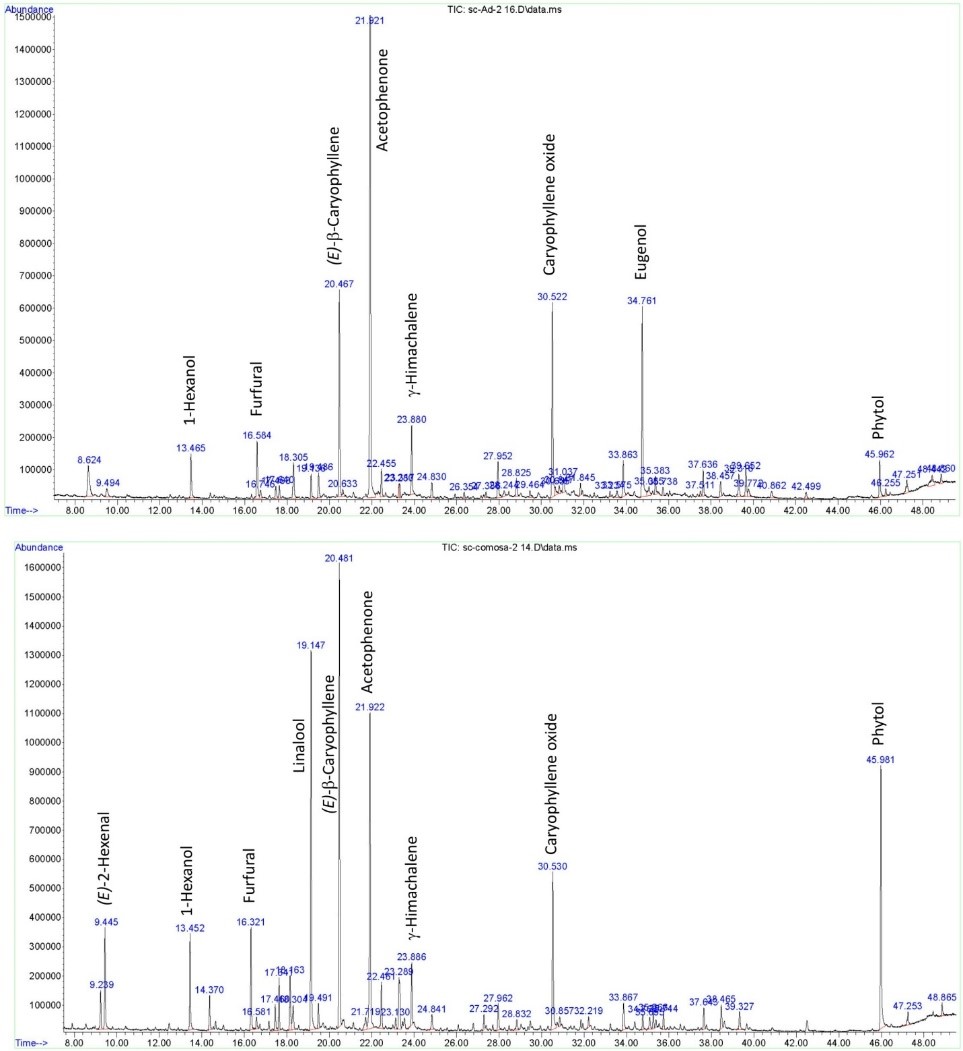ESSENTIAL OIL COMPOSITION OF TWO SPECIES OF SCUTELLARIA AERIAL PARTS
UDC 547.913:543.544.32
Abstract
The chemical composition of essential oils obtained by hydrodistillation method from two plants of the genus Scutellaria, grown in Uzbekistan and used in folk medicine were comparatively investigated by GC/MS and FID. Overall individually thirty three constituents were identified in both of aerial parts of S. adenostegia and S. comosa essential oils, representing 94.4 and 97.0% of the total, respectively. The main components were determined as acetophenone (24.2%), eugenol (12.3%), caryophyllene oxide (8.9%), and β-caryophyllene (7.0%) in the oil of S. adenostegia. β-Caryophyllene (12.5%), phytol (11.4%), linalool (11.1%), acetophenone (10.4%), caryophyllene oxide (6.6%),1-hexanol (5.3%), and (E)-2-hexenal (5.1%) were found as major components in the S. comosa oil. The composition of the oils of S. adenostegia and S. comosa was being reported for the first time. The essential oils of S. adenostegia and S. comosa showed significant antimicrobial properties against Bacillus subtilis, moderate effect against Salmonella enterica and Escherichia coli.
Downloads
Metrics
References
Shang X., He X., He X., Li M., Zhang R., Fan P., Zhang Q., Jia Z. J. Ethnopharmacol., 2010, vol. 128, pp. 279–313. DOI: 10.1016/j.jep.2010.01.006.
Karimov A.M., Botirov E.Kh. Russian J. Bioorg. Chem., 2017, vol. 43, pp. 691–711. DOI: 10.1134/S1068162017070068.
Khodjimatov K.Kh., Aprasidi G.S., Khodjimatov A.K. Dikorastushie celebniye rasteniya srednei azii. [Wilde type me-dicinal plants of Central Asia]. Tashkent, 1995, pp. 83–98. (in Russ.).
Tashmatov Z.O., Eshbakova K.A., Bobakulov Kh.M. Chem. Nat. Compd., 2011, vol. 47, pp. 440–441. DOI: 10.1007/s10600-011-9955-8.
Karimov A.M., Ostroushko Yu.V., Botirov E.Kh. Chem. Nat. Compd., 2019, vol. 55, pp. 545–546. DOI: 10.1007/s10600-019-02737-0.
Cicek M., Demirci B., Yilmaz G., Baser K.H.C. Nat. Prod. Res., 2011, vol. 25, pp. 1720–1726. DOI: 10.1080/14786419.2010.512997.
Dereboylu A.E., Sarikahya N.B., Sengonca N., Kirmizigul S., Yasa I., Gucel S., Guvensen A. Asian. J. Chem., 2012, vol. 24, pp. 4911–4916.
Miyazawa M., Nomura M., Marumoto S., Mori K. J. Oleo Sci., 2013, vol. 62, pp. 51–56. DOI: 10.5650/jos.62.51.
Nikbin M., Kazemipour N., Maghsoodlou M.T., Valizadeh J., Sepehrimanesh M., Davarimanesh A. Avicenna. J. Phytomed., 2014, vol. 4, pp. 182–190. DOI: 10.22038/AJP.2014.1863.
Mamadalieva N.Z., Sharopov F.S., Satyal P., Azimova S.S., Wink M. Nat. Prod. Res., 2017, vol. 31, pp. 1172–1176. DOI: 10.1080/14786419.2016.1222383.
Yu J., Lei J., Yu H., Cai X., Zou G. Phytochemistry, 2004, vol. 65, pp. 881–884. DOI: 10.1016/j.phytochem.2004.02.005.
Skaltsa H.D., Lazari D.M., Mavromati A.S., Tiligada E.A., Constantinidis T.A. Planta Med., 2000, vol. 66, pp. 672–674. DOI: 10.1055/s-2000-8650.
Skaltsa H.D., Lazari D.M., Kyriazopoulos P., Golegou S., Triantaphyllidis S., Sokovic M., Kypriotakis Z. J. Essent. Oil Res., 2005, vol. 17, pp. 232–235. DOI: 10.1080/10412905.2005.9698886.
Arıtuluk Z.C., Özkul Koçak C., Renda G., Ekizoğlu M., Ezer N. J. Res. Pharm., 2019, vol. 23, no. 3, pp. 552–558. DOI: 10.12991/jrp.2019.162.
Babushok V.I., Linstrom P.J., Zenkevich I.G. J. Phys. Chem. Ref. Data, 2011, vol. 40, no. 4, pp. 0431011–0431047. DOI: 10.1063/1.3653552.
Sarker S.D., Nahar L., Kumarasamy Y. Methods, 2007, vol. 42, pp. 321–324. DOI: 10.1016/j.ymeth.2007.01.006.
Dahham S.S., Tabana Y.M., Iqbal M.A., Ahamed M.B.K., Ezzat M.O., Majid A.S.A., Majid A.M.S.A. Molecules, 2015, vol. 20, pp. 11808–11829. DOI: 10.3390/molecules200711808.
Marchese A., Barbieri R., Coppo E., Orhan I.E., Daglia M., Nabavi S.F., Izadi M., Abdollahi M., Nabavi S.M., Ajami M. Crit. Rev. Microbiol., 2017, vol. 43, pp. 668–689. DOI: 10.1080/1040841X.2017.1295225.

Copyright (c) 2021 chemistry of plant raw material

This work is licensed under a Creative Commons Attribution 4.0 International License.

This work is licensed under a Creative Commons Attribution 4.0 International License.
The authors, which are published in this journal, agree to the following conditions:
1. Authors retain the copyright to the work and transfer to the journal the right of the first publication along with the work, at the same time licensing it under the terms of the Creative Commons Attribution License, which allows others to distribute this work with the obligatory indication of the authorship of this work and a link to the original publication in this journal .
2. The authors retain the right to enter into separate, additional contractual agreements for the non-exclusive distribution of the version of the work published by this journal (for example, to place it in the university depository or to publish it in a book), with reference to the original publication in this journal.
3. Authors are allowed to post their work on the Internet (for example, in a university repository or on their personal website) before and during the review process of this journal, as this may lead to a productive discussion, as well as more links to this published work.











